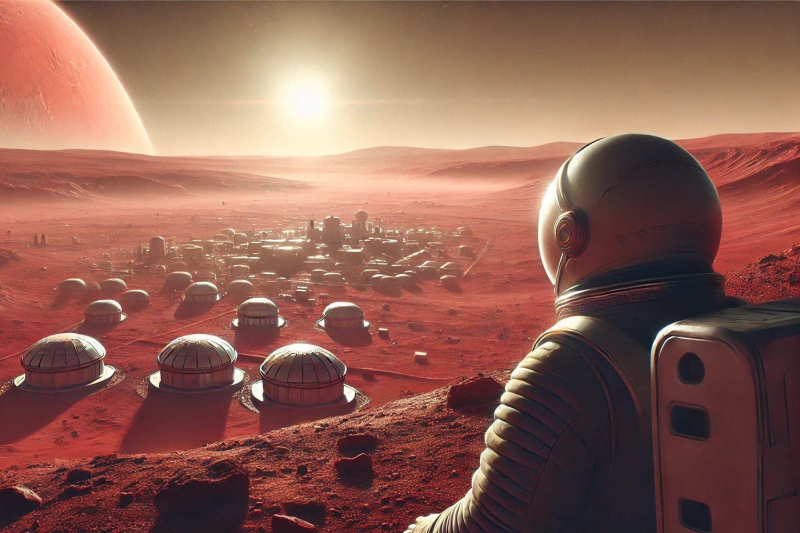
© Image generated by DALL-E AI for Presse-Citron
The prospect of Martian colonization, once confined to science fiction stories, is now emerging as a feasible fact thanks to the concerted efforts of engineers, researchers and space agencies. The dream of Musk and others: to transform the planet Mars into a viable long-term habitat for the human species. This quest nevertheless faces colossal challenges, which prove that we are still far from leaving our cradle to settle several tens of millions of kilometers away.
Generate a breathable atmosphere, be autonomous in food production, build sustainable habitats: the odyssey towards this new human frontier begins! announcement that is both complex and thrilling.
Warming Mars to make it habitable
One of the first stages of the terraforming of Mars will necessarily involve a reshaping of its gaseous envelope. Currently, its atmosphere is 95% carbon dioxide and has a density approximately one hundred times lower than that of our blue planet. Without a spacesuit or breathing apparatus, a human would die of asphyxiation within minutes due to lack of oxygen.
This atmospheric density also hinders the thermal retention of the planet, plunging Martian nights into freezing cold reaching -101° C. Various strategies have been considered to overcome this difficulty. One approach would be to divert water-rich comets to impact Mars, releasing trapped subsurface gases and water, while densifying the water. 8217;atmosphere. However, this approach would require a considerable number of comets and a technological mastery of redirection of celestial bodies that we do not yet possess.
Another possibility exists: the deployment of immense mirrors in orbit, reflecting sunlight towards the Martian surface to raise its temperature. A 2019 study proposed another solution: the application of airgel, an exceptionally light material, to Martian soil. Acting as a thermal insulator, this technique could be exploited to cause the melting of polar ice caps and generate valuable water resources.
Producing food on Mars: a herculean undertaking
On our planet, the fertile soil is made up of a mixture of minerals, organic matter, microorganisms, gases and ;#8217;water, allowing us to grow what we want. On the other hand, the Martian surface is lined with regolith, a sandy substance devoid of the nutrients essential for plant development and containing perchlorates, toxic and potentially carcinogenic substances. Transforming this inhospitable substrate into cultivable soil represents a monumental mission.
200% Deposit Bonus up to €3,000 180% First Deposit Bonus up to $20,000Researchers are therefore considering the introduction of extremophile organisms, in this case microbes capable of thriving in extreme conditions, in order to enrich the Martian soil. These organisms could be genetically modified to optimize their ability to transmute carbon dioxide into oxygen through photosynthesis. Ultimately, this could create a biotope conducive to the growth of more complex plants, or even the survival of animals. However, balancing the proportions of oxygen, water and nutrients remains a considerable challenge and we are far from having solved this equation.
3D printing for habitats
The construction of habitats capable of preserving the pioneers of hostile conditions constitute one of the essential challenges of Martian colonization. Currently NASA is working on the Moon-to-Mars Planetary Autonomous Construction Technologies program, exploring the potential of 3D printing to erect structures on the red planet. These buildings would initially be pressurized and protected, pending an evolution of Martian atmospheric and thermal conditions towards more lenient parameters.
L& ;#8217;absence of magnetosphere on Mars raises another major pitfall. Deprived of this natural shield, the colonists would find themselves exposed to harmful solar and cosmic radiation. Among the solutions envisaged is the creation of artificial magnetic fields, although this technology still remains at a purely theoretical stage. In this specific case, we are still in the middle of science fiction.
This is what we still have to complete before considering the slightest colony in Martian space. Some experts (Elon Musk, Buzz Aldrin or Neil deGrasse Tyson) see in this project an essential step in the salvation of our humanity, an opportunity to expand our civilization beyond Earth and guarantee our survival as a species. On the other hand, others (Stephen Hawking, Bill Nye or Carl Sagan) point the finger at the disproportionate scale of the task and the exorbitant costs associated with it. to such an enterprise, as well as the potential risks for astronauts and the Martian environment. Let's put it into perspective: it is possible that we will never see the first colony erected given the many obstacles remaining to be overcome.
- To make Mars habitable, it will be necessary to warm and densify its atmosphere.
- It will also be necessary to produce food locally, which which requires completely transforming the planet's soil.
- Another elementary point: the construction of sustainable habitats to protect future settlers.
📍 For miss any news from Presse-citron, follow us on Google News and WhatsApp.
[ ]

